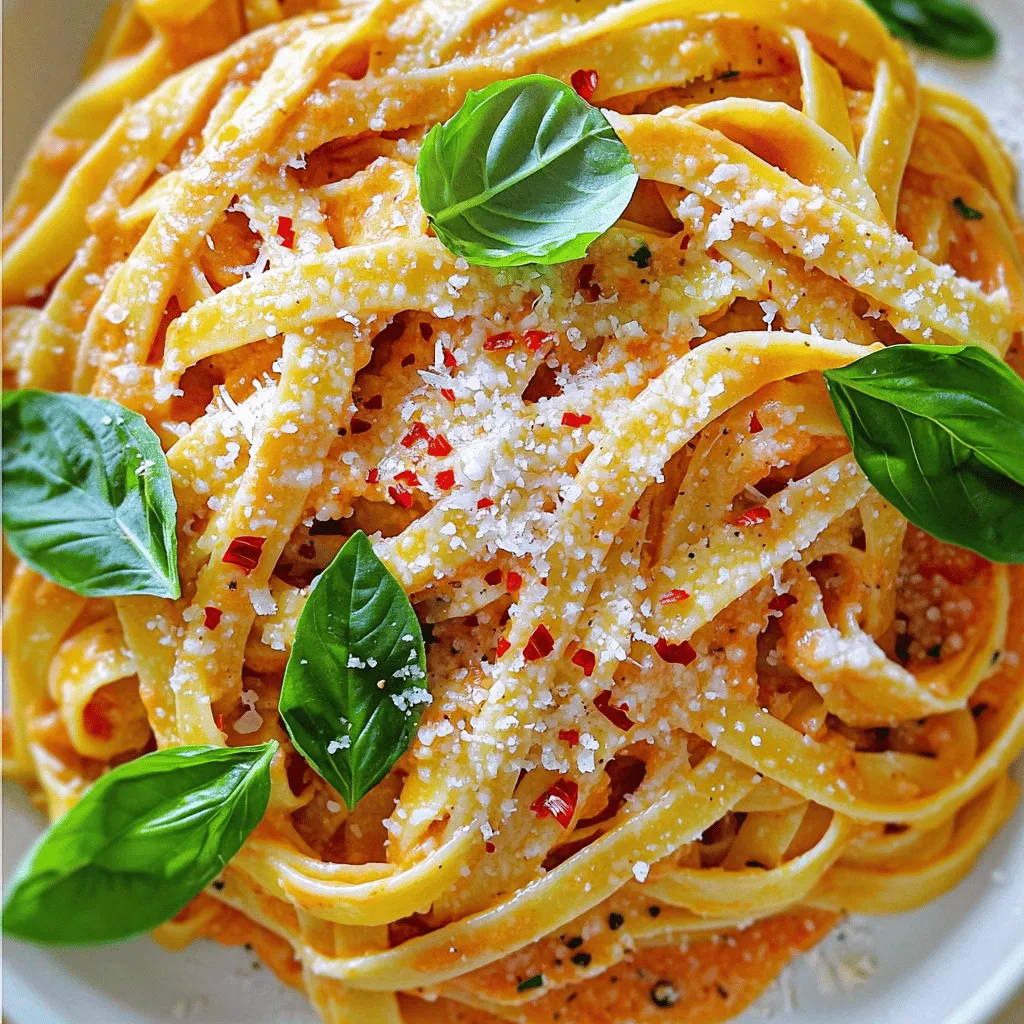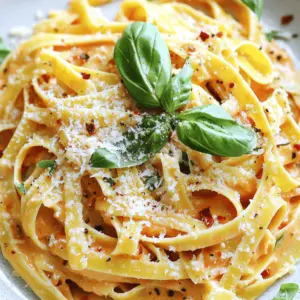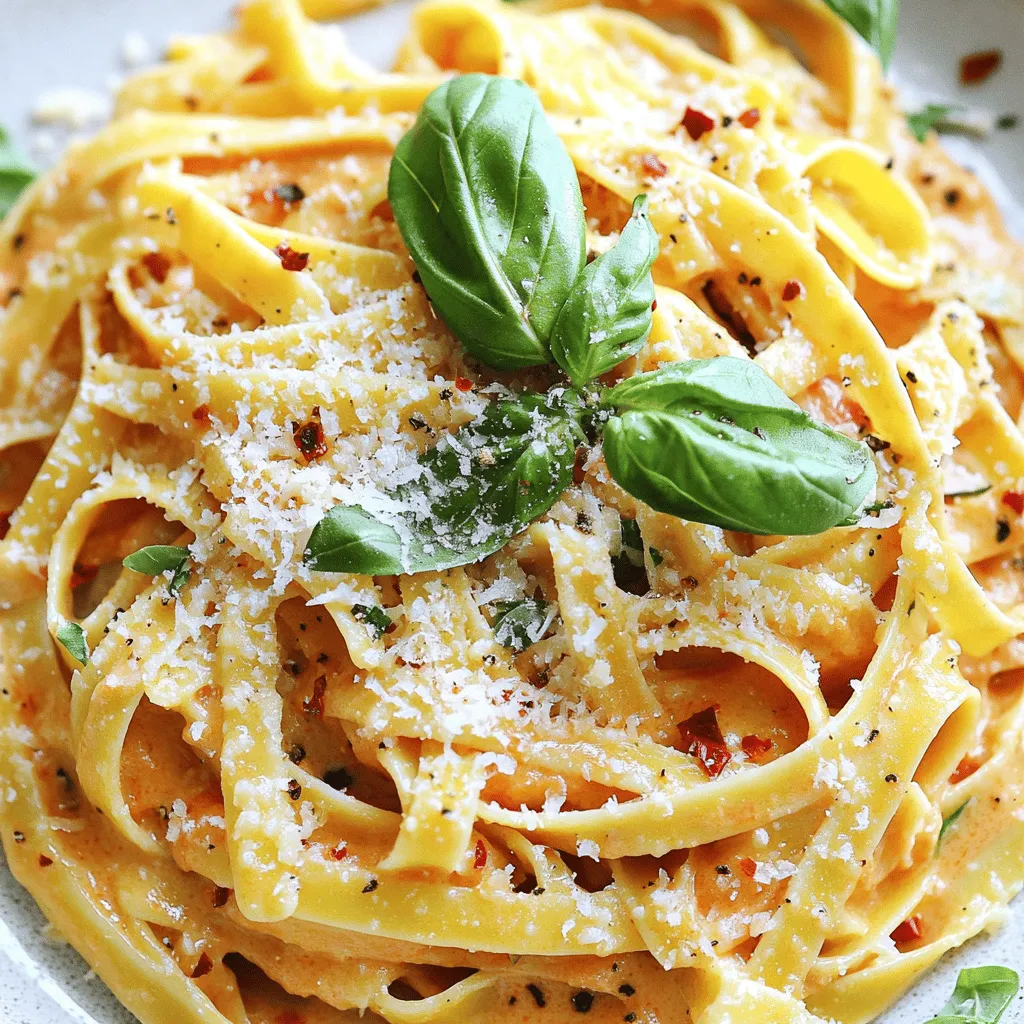If you crave a meal that’s both rich in flavor and simple to make, look no further! Creamy Garlic Tomato Pasta is your answer. This dish bursts with fresh ingredients and can be whipped up in no time. You’ll learn how to choose the best pasta, make a delicious sauce, and even customize it to your taste. Let’s dive into this easy recipe that will impress your family and friends!
Ingredients
Pasta Selection
Fettuccine vs. Linguine
When making creamy garlic tomato pasta, you can choose between fettuccine and linguine. Fettuccine is wider, giving a hearty bite. Linguine is thinner, allowing the sauce to cling well. Both options work great, so pick your favorite!
Gluten-free alternatives
If you need gluten-free pasta, options abound. Many brands offer gluten-free fettuccine or linguine. You can also use rice or quinoa pasta. These alternatives taste good and fit perfectly with the creamy sauce.
Essential Ingredients
Overview of key ingredients
The main ingredients for this dish include pasta, garlic, tomatoes, and cream. You will also need olive oil, basil, oregano, and red pepper flakes for flavor. Each element adds to the creamy, rich taste.
Importance of fresh basil and Parmesan
Fresh basil and Parmesan cheese make this dish special. Basil adds a bright flavor that lifts the sauce. Freshly grated Parmesan gives a salty, nutty taste that enhances the creaminess. Always use quality ingredients for the best results!
Possible Substitutions
Alternatives for heavy cream
If you want a lighter option, you can use half-and-half or whole milk. Coconut cream works well for a dairy-free choice. Each alternative will change the flavor slightly, but you still get a creamy sauce.
Using fresh tomatoes vs. canned
Fresh tomatoes can be used instead of canned. If you choose fresh, use ripe tomatoes for the best flavor. Just chop them and cook longer to let them break down. Canned tomatoes are great for their convenience and consistent taste.
Step-by-Step Instructions
Cooking the Pasta
Start by boiling a large pot of salted water. This helps the pasta taste good. Once it boils, add 12 ounces of fettuccine or linguine. Cook it according to the package. Usually, that takes about 8 to 10 minutes. You want it to be al dente, meaning it should have a little bite. Before you drain the pasta, save 1 cup of the pasta water. This starchy water helps the sauce stick later.
Preparing the Garlic Tomato Sauce
In a large skillet, add 2 tablespoons of extra virgin olive oil. Heat it over medium heat. Once warm, add 4 finely minced garlic cloves. Sauté the garlic for about 1 minute. Watch it closely so it doesn’t burn. Burnt garlic can make the dish taste bitter. After that, pour in a 14-ounce can of fire-roasted crushed tomatoes. Stir well and let it simmer on low heat for about 5 to 7 minutes. This step helps all the flavors mix.
Creating the Creamy Texture
Now, it’s time to make the sauce creamy. Slowly stir in 1 cup of rich heavy cream. Then, add 1 teaspoon of dried basil, 1 teaspoon of dried oregano, and ½ teaspoon of red pepper flakes. Mix everything together and let it simmer for an extra 5 minutes. This helps the sauce thicken a bit. Don’t forget to taste it! Add salt and freshly ground black pepper to make it just right.
Combining Pasta and Sauce
Next, gently fold the drained pasta into the skillet. Toss it well with the creamy tomato sauce. If the sauce seems too thick, you can add some of that reserved pasta water. Just add it a little at a time until the pasta is nicely coated. This step makes sure every strand of pasta is delicious.
Serving Suggestions
When you’re ready to serve, take the skillet off the heat. Spoon the pasta into deep bowls or onto plates. For a beautiful look, drizzle a bit of extra virgin olive oil on top. Garnish with fresh basil leaves and a generous sprinkle of grated Parmesan cheese. This adds color and flavor, making your dish look great!
Tips & Tricks
Avoiding Common Mistakes
– Preventing overcooked garlic: Cook the garlic for just one minute. Keep an eye on it. If it turns brown, it can taste bitter.
– Balancing flavors in the sauce: Taste the sauce as you cook. Adjust salt and pepper to find the right balance.
Enhancing Flavor
– Adding additional spices or herbs: Try adding a pinch of thyme or parsley. This can boost the sauce’s aroma and taste.
– Drizzling olive oil for extra richness: A touch of extra virgin olive oil on top adds flavor and a lovely sheen.
Making It Ahead
– Preparing in advance tips: You can cook the pasta and sauce ahead of time. Just combine them before serving.
– Reheating pasta without losing texture: When reheating, add a splash of reserved pasta water. This helps keep the sauce creamy and smooth.

Variations
Protein Additions
You can add protein to your creamy garlic tomato pasta for a heartier meal. Here are some ideas:
– Chicken: Grilled or sautéed chicken breast works great.
– Shrimp: Cook shrimp in the garlic oil for a tasty twist.
– Sausage: Italian sausage adds a nice kick and flavor.
For a vegetarian option, consider adding:
– Tofu: Firm tofu can soak up the sauce well.
– Chickpeas: These add protein and a nice texture.
Veggie Enhancements
Boost the nutrition of your dish with veggies. Here are my favorites:
– Spinach: Toss in fresh spinach for vibrant color and health.
– Kale: This adds a nice crunch and is very nutritious.
You can also try:
– Bell Peppers: Sauté them with garlic for extra sweetness.
– Zucchini: Thinly sliced zucchini adds moisture and flavor.
Flavor Profiles
Experimenting with flavors can elevate your dish. Here are some tips:
– Different Cheeses: Try goat cheese or feta for a tangy taste.
– Adjust Spice Levels: Add more or less red pepper flakes based on your heat preference.
You can also add:
– Fresh Herbs: Basil or parsley can add a fresh kick.
– Lemon Zest: A squeeze of lemon brings brightness to the dish.
These variations make your creamy garlic tomato pasta fun and flexible. Enjoy creating your perfect meal!
Storage Info
Refrigeration
To store your creamy garlic tomato pasta, place any leftovers in an airtight container. This helps keep it fresh. It lasts in the fridge for about 3 to 4 days. Always let it cool before sealing. This prevents condensation and keeps the pasta from getting mushy.
Freezing Options
You can freeze creamy garlic tomato pasta, but it’s best to freeze it without the cream. For freezing, cool the pasta completely. Divide it into portions and place it in freezer bags. Squeeze out the air to prevent freezer burn. It will last for about 2 months. When you’re ready to eat, thaw it in the fridge overnight.
Thawing and Reheating Instructions
To reheat, gently warm the pasta on the stove. Add a splash of heavy cream to help revive its creaminess. Stir often to heat evenly. You can also microwave it, but add a bit of water or cream to keep it moist.
Reheating Tips
The best way to maintain creaminess is to reheat slowly. Avoid high heat, as it can cause the sauce to separate. Stir in extra cream if it seems too thick. This keeps the pasta smooth and delicious. Always check for seasoning after reheating. If it tastes bland, add a pinch of salt or pepper.
FAQs
What can I use instead of heavy cream?
You can use several lighter options. Consider using milk with a bit of flour or cornstarch. This mix helps mimic cream’s thickness. Another choice is coconut cream for a dairy-free option. Silken tofu blended with a little water also works well. These options keep your dish creamy without the heavy cream.
Can I make this recipe vegan?
Yes, you can easily make this dish vegan. Replace heavy cream with canned coconut milk or cashew cream. Use vegetable broth and a splash of non-dairy milk for added creaminess. Choose nutritional yeast instead of Parmesan cheese for flavor. You can also add veggies like mushrooms or spinach for extra nutrition.
How do I make the sauce thicker?
If you want a thicker sauce, use a few simple tricks. First, let the sauce simmer longer to reduce it. This allows excess water to escape. You can add a cornstarch slurry; mix cornstarch with cold water and stir it in. Lastly, adding more cheese thickens the sauce nicely.
Can I use fresh tomatoes instead of canned?
Absolutely! Fresh tomatoes can add great flavor. Use about 2-3 cups of diced fresh tomatoes. Cook them down until soft before adding the cream. If you want more depth, roast them first. This brings out their natural sweetness and enhances your sauce.
How to store leftovers properly?
To keep your pasta fresh, store it in an airtight container. Place it in the fridge and eat it within 3 days. If you want to freeze it, separate the pasta from the sauce. This helps maintain texture when reheating. Use freezer-safe containers, and it will last up to 3 months.
This blog post covers everything you need for a tasty pasta dish. You learned how to select the right pasta and essential ingredients. Fresh basil and Parmesan are key. I shared tips for cooking pasta perfectly and creating a rich sauce. You can enhance flavors and try fun variations.
Remember to store leftovers the right way for best taste. Cooking pasta at home can be fun and rewarding. Enjoy sharing your creations with family and friends!

